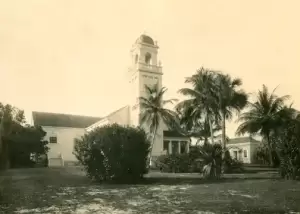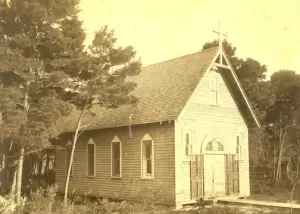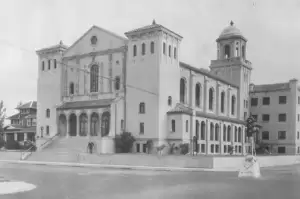Teaching and Preaching: Houses of Worship

After Flagler made the Royal Poinciana Chapel in Palm Beach officially non-denominational, the Congregationalists began to meet instead across the lake at the Rymer home at Evernia Street and Narcissus Avenue. Beginning in November 1894, the women raised money for months to build a church, as Miriam Stowers describes, below. Stowers depicts the earliest days of West Palm Beach, when it was filled with workmen building the Royal Poinciana Hotel:
Those men, a good many of them … were Protestants and didn’t have any place of their own to go. There were . . . maybe two streets about three blocks long of people living there—among them, a Mr. and Mrs. White. [He was] a Philadelphia lawyer. And then there was an old lady who was born when her mother was crossing the desert years and years before, going out west, and she was a terrific character. She could swear better than almost any sailor and all sorts of things and was so kind to children. She and a gentleman had this store together and it was quite important in that little town.
Anyhow, she thought there should be a Protestant church, and the lawyer thought so, and different people around town thought so. So these two women—the dainty little lady from Philadelphia and this very sort of masculine woman who was born crossing the desert—took a market basket and stood at the head of the dock where the workmen came from the Poinciana to West Palm Beach. And they picked an afternoon after the workmen had been paid … and said, “Would you like to help build a Protestant church in West Palm Beach?” And these men, like all big-hearted men, just put practically everything out of their pay envelopes into that basket.
Well, at that time there was one street in West Palm [Banyan], which was entirely given over to saloons and such things. And across the street from the first saloon, there was a little building with an upstairs apartment in which the first saloonkeeper [lived with his wife]. She saw the money being dropped in the basket; she saw those men go right past not only her husband’s saloon, but every saloon right up the street. So she came down to investigate. And the nice woman from out west and the little German wife of the saloonkeeper began to use all sorts of words that were not in the church category for ladies to use. And this pleased the workmen very much so they stopped and they listened and they laughed and they cheered and they clapped and they put their money into the basket. The little lady from Philadelphia held the basket.Miriam Stowers
When Flagler learned the Congregationalists had made a $25.00 down payment on a lot at Evernia and Olive—owned by his Model Land Company—he deeded them the lot free and clear. Contractor Charles C. Haight completed the building by August 1895. In 1896 the Congregationalists recorded 21 families in their church plus a hundred affiliated members.
The Reverend Asbury Caldwell was the first minister, in June 1895, and contributed to a meeting for incorporating Miami a year later. Sometime between 1896 and 1900, Rev. Caldwell was convicted of poisoning his wife. It is unknown what became of their other children, but in 1900 one was living as Miriam Stowers, daughter of John and Mary Stowers, founding members of the Congregational church. Miriam related the above account when she was 70 years old, as “one of her pet stories about this part of the world.”
One of the trustees agreed to move the wooden chapel, placing it on his lot and allowing the congregation to use the building until the new church was completed. The move was to be made between Sundays, but halfway down Datura Street, a cable broke and a replacement could not be found south of Jacksonville. Sunday was coming with nowhere to meet, so the building was blocked up in the middle of Datura, and there Sunday School was held!
The Jewish Community
While Florida was a territory from 1822 to 1845, all kinds of settlers were welcome, as Florida could not be granted statehood until its population reached 60,000. Until the railroads made travel more feasible, however, those Jews who trickled into Florida stayed in north Florida. In the 1890s, there were about 2,500 Jews living in all of Florida.

West Palm Beach was probably the one of the first south Florida communities with Jewish residents, as they rode in on Flagler’s railroad. The early arrivals opened retail stores on Narcissus and Clematis. Max Sirkin (1868-1933), a Russian immigrant, came to the United States about 1880 via Canada. He settled in West Palm Beach in 1896 with his wife Rebecca Wolfe of London, England. He entered into a partnership with his father-in-law to operate a men’s furnishing store and later bought Mr. Wolfe out. Max renamed the store the Sirkin Company, a shoe, clothing, and hat store on Clematis Street. He sold the business to the Palm Beach Shoe Company in 1919. He also served on the West Palm Beach City Commission. Carl Schrebnick’s Honest Profit House was still one of the few Jewish-owned businesses in 1900.
The Episcopalians
The Methodists
A Methodist Church was established in 1896 as well, which built a small frame chapel in 1898. The West Palm Beach Town Council donated $25.00 toward the church bell, which also served as an alarm for the town marshal and for the Flagler Alerts, the volunteer fire department. In 1914 a brick church costing about $60,000 replaced the chapel.



